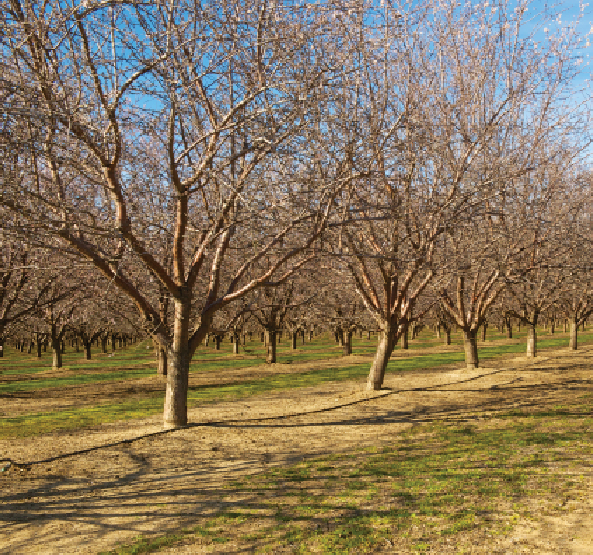As the liquid gold falls from the heavens in December and January (we hope!), tree nut farmers get a bit of a reprieve from the crazy schedules spring will deliver. We pistachio farmers still make our daily pilgrimage to the computer to check our chilling hours, making sure the requirements will be met. Almond farmers keep a close eye on the temperatures to make sure a deep freeze isn’t in the forecast, ruining those delicate, precious little buds so close to bloom. Pecan and walnut farmers laugh at us a bit as they typically have a little less to worry about. It’s in this time we often overlook the fact that the ground may not be much below 50 degrees F (if at all) and the roots are still active, although a bit sluggish. Don’t forget about them.
As we probe the soil in an early attempt to see what Mother Nature may have already cleaned up in our winter leaching events, we often see those little white hair roots emerging from our main root systems. Energy is being used to push those hungry little growths into our soil. This often requires phosphorus and lots of carbon. Carbon can be thought of like the arms of a quadropus. Okay, I think I just made that up because an octopus has eight arms. Carbon only has four. Those four symmetrically charged and balanced connection points are what makes life happen. Biology feeds on it. Nutrients attach to it. Sugar and fat are made from it. Fungi break down detritus into organic matter which in turn holds more water and nutrients. And fittingly enough, the Good Lord has perfectly created the system whereby the exudates roots secrete are full of it. This feeds the beneficial soil biology which in turn mine and etch the mineral nutrients, allowing them to assimilate into the plant’s vascular system. The whole process is pretty elaborate. We always seem to focus on the 17 nutrients we classify as essential. However, none of it happens without carbon, hydrogen and oxygen, mostly in the form of CO2 and water; 95% of a plant’s makeup.
But the phosphorus is much more difficult to come by. Life needs phosphorus to create ATP to fuel the fire of life. The problem arises when we realize our fertilizer forms are, typically, mostly polyphosphates that a plant cannot drink. Polyphosphates can break down into orthophosphate in as quickly as four days…in July. What about the cold soil temperatures of January through April? It can take as long as 100 days to cleave the polys into ortho. Furthermore, biology, which drives the transformation, isn’t as active or as reproductive in the cold, anaerobic spring. So, what do we do?
Hedge your bet. Start earlier. I’m not saying turn the pumps on and run 24-hour sets. I’m saying use your system to fertigate early in short shots. Apply small amounts of orthophosphate materials. Trees need N and P early for bud break. Our nutrient demand curves tell us that. N and P trend down as the season progresses, unlike calcium, potassium and magnesium that trend up. If we did a good job of replenishing our trees post-harvest, focus on the P. Most of the tree’s N demand can be met with the amounts the trees stored in their roots over winter. If not, add a little. By a little, I’m only talking five to ten units, max. Not to beat a dead quadropus here, but applying too much P early (more than a plant can drink in a day or two) will just tie up all that excessive, stable calcium we may have used to amend the soil in the fall. If a tree’s P demand is typically 10% of its N demand, those early shots of polyphosphate fertilizers totaling 30 units or more are very ineffective. It needs to be spread out over a few months. When it’s cold and wet, it has to be in a form that a plant can actually drink.
Go a step further. Add some carbon. Humic acids, sugars, carbohydrates, etc. all help to feed the plants and the soil biology. Give the roots extra carbon for the spring push. Take one more step. Add some active biology to the soil. When we fertigate, the well water is quite a bit warmer than the soil. Adding some extra biology with a little heat will get things moving in the root zone a bit quicker. As much as we don’t want to apply any more of that liquid gold than we have to, using it to get early nutrition at a critical time will get things off to a good start. The quicker a tree’s nutritional demands are met, the better chance we have of realizing optimal yields. It takes a bit more effort, but isn’t that what we typically do as farmers anyways? Sometimes, we have to work a little bit harder and smarter, but seeing more full loads in our orchards in the fall make it all worth it.











